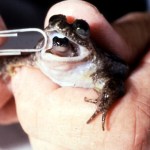endangered
In true MacGyver fashion, an employee at the Rainbow Springs Nature Park in New Zealand
repaired a damaged kiwi bird egg with masking tape thus protecting the chick from dehydration. The newly hatched bird was appropriately named Fissure.
Photo of Fissure from Rainbow Springs Nature Park.
If you happen to be in the Arctic this summer polar bears (Ursus maritimus) can be spotted spending their time on the sea ice or on the shore in areas where ice has melted. While it is difficult to study the physiology of bears living on the ice, it had been hypothesized that bears living on shore experience a state similar to winter hibernation in which they attempt to decrease their energy expenditure when food resources are low. However, new research published in Science shows that bears living on the ice as well as those on shore experience some decrease in…
Conservationists are trying hard to save the Devils Hole pupfish (Cyprinodon diabolis) from extinction. With less than 100 animals remaining, a captive breeding program was started at the University of California, Berkeley.
As you can imagine from the image below, the geographic range of this fish is smaller than other wild vertebrates. They are only found in the limestone caverns of the geothermal Devils Hole pool in Death Valley, Nevada. The pool is 3m wide, 20m long, 426 feet deep, and a very warm 92-93 degrees Fahrenheit. It is thought to have formed more than 500,000 years ago…
This article is reposted from the old Wordpress incarnation of Not Exactly Rocket Science.
Twenty-two thousand sounds like a huge number. It's happens to be number of eastern Pacific gray whales currently swimming off the coast of North America. It's certainly much larger than 140, the number of whales that aboriginal people of this area are allowed to hunt. And it's far, far bigger than zero, the population size that the whales were rapidly approaching in the mid 20th century.
Obviously, it's all relative. Twenty-two thousand is still much less than ninety-six thousand. That's the size of…
Birth of the Gastric Brooding Frog
Photo Mike Tyler
Unfortunately, species are the ultimate bioephemera.
Amphibians in particular have been declining at an alarming rate over the past several decades; some estimates suggest that a third of amphibian species are on the verge of extinction. My latest essay for SEED's website opens with the story of the Gastric Brooding Frog, Rheobatrachus silus, an extremely peculiar species. It was discovered in the 1970s, and already believed extinct just over a decade later. That's barely enough time to describe a species, much less save it.
Save the Frogs…
Photo by Tracy Woodward, WaPo
Yesterday, zookeepers at the National Zoo's Conservation and Research Center discovered two newborn clouded leopard cubs in the enclosure of their mother, Jao Chu. This is a big deal because it is notoriously difficult to breed clouded leopards in captivity: males can attack and kill females with whom they aren't properly bonded, and captive mothers often inadvertently or deliberately kill their cubs. Because of that risk, these two cubs were taken from Jao Chu to be raised by human researchers.
Jao Chu and her mate Hannibal were imported from Thailand last…
A quick wrap-up of the animals discovered not to be extinct this week:
Armoured mistfrog
This Armoured Mistfrog, thought by many experts to be extinct due to the recent amphibian chytrid fungus epidemic, was rediscovered by my boss, enterprise search god, Chris Cleveland, while he should have been working, on CNN. And more specifically, in a remote tropical area in northern Australia.
Tadpole Shrimp
Heavy rains in Scotland have created perfect conditions for the reemergence of the tadpole shrimp, thought extinct in the UK until recently. The little critter resembles a tiny horseshoe crab…

